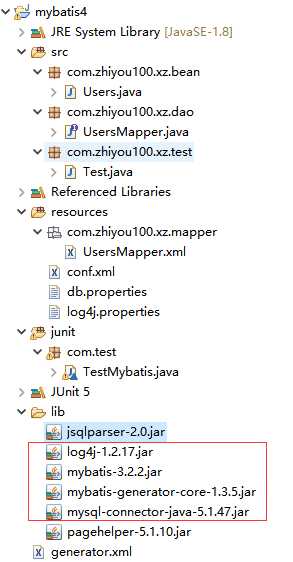mybatis学习日志二
Posted sitian2050
tags:
篇首语:本文由小常识网(cha138.com)小编为大家整理,主要介绍了mybatis学习日志二相关的知识,希望对你有一定的参考价值。
一、动态sql语句
- if语句
- if+where语句
- if+set语句
- choose(when,otherwise)语句
- trim语句
- sql片段
- foreach语句
- 总结
bean部分的User类代码:
public class User private int id; private String name; private int age;//如果在if判断中用null,则把int改成Integer private String sex; private List<Integer> ids;
dao部分的接口UserDao代码:
public interface UserDao /** * 根据id查询 * @param id * @return */ public User selectByWhere1(User user); public User selectByWhere2(User user); public User selectByWhere3(User user); /** * 添加 * @param user */ public void addUser(User user); /** * 删除用户 * @param id */ public void deleteByIds(User ids); public void delete(@Param("ids") List<Integer> ids); //调用其他的类型要先设置key,Mybatis默认为map public void deleteByIds2(User ids); /** * 更新用户 * @param user */ public void updateUser(User user);
以下为mapper.xml部分:
1.if语句
<!-- 根据name和sex来查询数据。如果name为空,那么将只根据sex来查询;反之只根据name来查询
缺点:如果第二个条件满足,第一个条件不满足,那么就会导致sql语句出错
where 1=1 防止where后面什么也没有会报错
-->
<select id="selectByWhere1" parameterType="int" resultType="com.zhiyou100.xz.bean.User"> select * from users <if test="name!=null"> where name=#name </if> <if test="sex!=null and sex!=‘‘"> and sex=#sex </if> </select>
2.if+where 语句
<!-- 解决:如果第二个条件满足,第一个条件不满足,那么就会导致sql语句出错
if+where:如果第一个条件满足,则用where,并去掉where后的and
-->
<select id="selectByWhere2" resultType="com.zhiyou100.xz.bean.User"> select * from users <where> <if test="name!=null"> and name=#name </if> <if test="sex!=null and sex!=‘‘"> and sex=#sex </if> </where> </select>
3. if+set 语句
<!-- if+set:如果传来的字段为null,那么保留原来的内容 --> <update id="updateUser" parameterType="com.zhiyou100.xz.bean.User"> update users <set> <if test="name!=null"> name=#name, </if> <if test="sex!=null and sex!=‘‘"> sex=#sex, </if> <if test="age>0"> age=#age </if> </set> where id=#id </update>
4. choose(when,otherwise) 语句
<!-- choose+where+otherwise --> <select id="selectByWhere3" resultType="com.zhiyou100.xz.bean.User"> select * from users <where> <choose> <when test="name!=null and name!=‘‘"> name like concat(‘%‘,#name,‘%‘) </when> <when test="sex!=null and sex!=‘‘"> sex=#sex </when> <otherwise> age>=#age </otherwise> </choose> </where> </select>
5. trim 语句
<!-- trim -->
<select id="selectByWhere2" resultType="com.zhiyou100.xz.bean.User">
select * from users
<trim prefix="where" prefixOverrides="and / or">
<if test="name!=null">
and name=#name
</if>
<if test="sex!=null and sex!=‘‘">
and sex=#sex
</if>
</trim>
</select>
<!-- trim -->
<update id="updateUser" parameterType="com.zhiyou100.xz.bean.User">
update users
<!--
prefix:把trim中返回的字符串前添加一个set
prefixOverrides:覆盖trim中返回的字符串的前缀为and | or
suffix:把trim中返回的字符串后添加一个指定字符串
suffixOverrides:覆盖trim中返回的字符串的前缀
-->
<trim prefix="set" suffixOverrides=",">
<if test="name!=null">
name=#name,
</if>
<if test="sex!=null and sex!=‘‘">
sex=#sex,
</if>
<if test="age>0">
age=#age
</if>
</trim>
where id=#id
</update>
6. SQL 片段
<!-- sql片段 -->
<sql id="usercolumns">
id,name,age,sex
</sql>
<select id="selectByWhere1" parameterType="int" resultType="com.zhiyou100.xz.bean.User">
select
<!-- 引用相应的sql片段 -->
<include refid="usercolumns" />
from users
<if test="name!=null">
where name=#name
</if>
<if test="sex!=null and sex!=‘‘">
and sex=#sex
</if>
</select>
7. foreach 语句
<!-- delete from users where id in(?,?,?) --> <delete id="deleteByIds"> delete from users where id in <!-- collection:表示要遍历的集合名称 open:以(作为开始 close:以)作为结束 separator:每个元素之间使用,分割 item:每次遍历的值赋值给的变量名 --> <foreach collection="ids" open="(" close=")" separator="," item="id"> #id </foreach> </delete> <!-- delete from users where id=1 or id=4 or id=6 --> <delete id="delete"> delete from users <!-- collection:表示要遍历的集合名称 open:以(作为开始 close:以)作为结束 separator:每个元素之间使用,分割 item:每次遍历的值赋值给的变量名 这里最好不要在foreach标签中用open="where " 因为当id等于0时,做全表删除时会报错 --> <where> <foreach collection="ids" separator="or" item="id"> id=#id </foreach> </where> </delete>
8. 总结
其实动态 sql 语句的编写往往就是一个拼接的问题,为了保证拼接准确,我们最好首先要写原生的 sql 语句出来,然后在通过 mybatis 动态sql 对照着改,防止出错。
二、逆向工程
通过前面的学习,在实际开发中,我们基本上能对mybatis应用自如了,但是我们发现了一个问题,所有操作都是围绕着po类,xxxMapper.xml文件,xxxMapper接口等文件来进行的。如果实际开发中数据库的表特别多,那么我们需要手动去写每一张表的po类,xxxMapper.xml,xxxMapper.java文件,这显然需要花费巨大的精力,而且可能由于表字段太多,写错了而不知道也是可能的。
所以我们在实际开发中,一般使用逆向工程方式来自动生成所需的文件,如dao,bean,xml映射文件 。
http://www.mybatis.org/generator/index.html
1.新建一个工程并导入jar包

注意:使用逆向工程时,最好新建一个工程,如果你在原来的工程中使用,那也可以,但是有一定的风险,因为mybatis是根据配置文件中配置的路径来生成的文件的,如果你工程中有相同名字的文件,那么就会被新生成的文件所覆盖。所以实际开发中,我们一般新建一个工程,将生成的文件复制到自己的所需的工程中。
2.创建generator.xml配置文件
<?xml version="1.0" encoding="UTF-8"?> <!DOCTYPE generatorConfiguration PUBLIC "-//mybatis.org//DTD MyBatis Generator Configuration 1.0//EN" "http://mybatis.org/dtd/mybatis-generator-config_1_0.dtd"> <generatorConfiguration> <!-- mysql驱动jar所在的位置 --> <classPathEntry location="D:\\\\mysql\\\\mysql-connector-java-5.1.47.jar" /> <!-- 数据源的信息 --> <context id="DB2Tables" targetRuntime="MyBatis3"> <!-- 禁止所有注释 --> <commentGenerator> <property name="suppressAllComments" value="true" /> </commentGenerator> <jdbcConnection driverClass="com.mysql.jdbc.Driver" connectionURL="jdbc:mysql://localhost:3306/mybatis" userId="root" password="root"> </jdbcConnection> <javaTypeResolver > <property name="forceBigDecimals" value="false" /> </javaTypeResolver> <!-- 生产的实体类所在的位置 --> <javaModelGenerator targetPackage="com.zhiyou100.xz.bean" targetProject="./src"> <property name="enableSubPackages" value="true" /> <property name="trimStrings" value="true" /> </javaModelGenerator> <!-- 生成的映射文件所在的位置 --> <sqlMapGenerator targetPackage="com.zhiyou100.xz.mapper" targetProject="./resources"> <property name="enableSubPackages" value="true" /> </sqlMapGenerator> <!-- 生产的dao文件所在位置 --> <javaClientGenerator type="XMLMAPPER" targetPackage="com.zhiyou100.xz.dao" targetProject="./src"> <property name="enableSubPackages" value="true" /> </javaClientGenerator> <!-- 某张表与实体类的对应关系 schema:该表所在的数据库 tableName:表名 domainObjectName:实体类名
当需要多张表建立实体类时要建立多个table标签 --> <table schema="mybatis" tableName="users" domainObjectName="Users" enableCountByExample="false" enableSelectByExample="false" enableUpdateByExample="false" enableDeleteByExample="false">
<!--以Example结尾的属性全为false,是为了减少生成复杂的方法 --> <property name="useActualColumnNames" value="true"/> <generatedKey column="ID" sqlStatement="DB2" identity="true" /> <columnOverride column="DATE_FIELD" property="startDate" /> <ignoreColumn column="FRED" /> <columnOverride column="LONG_VARCHAR_FIELD" jdbcType="VARCHAR" /> </table> </context> </generatorConfiguration>
注意:
1、连接数据库的配置,包括数据名称,数据库用户名密码等配置
2、指定要生成代码的包名,包括实体类po的包名,mapper的包名等
3、指定数据库中哪些表需要生成文件
3.运行主程序生成代码
package com.zhiyou100.xz.test; import java.io.File; import java.util.ArrayList; import java.util.List; import org.mybatis.generator.api.MyBatisGenerator; import org.mybatis.generator.config.Configuration; import org.mybatis.generator.config.xml.ConfigurationParser; import org.mybatis.generator.internal.DefaultShellCallback; public class Test public static void main(String[] args) throws Exception List<String> warnings = new ArrayList<String>(); boolean overwrite = true; File configFile = new File("generator.xml"); ConfigurationParser cp = new ConfigurationParser(warnings); Configuration config = cp.parseConfiguration(configFile); DefaultShellCallback callback = new DefaultShellCallback(overwrite); MyBatisGenerator myBatisGenerator = new MyBatisGenerator(config, callback, warnings); myBatisGenerator.generate(null);
三、分页查询助手pagehelper
1.导入jar包

2.在mybatis工程下的conf.xml中配置拦截器插件
<!-- plugins在配置文件中的位置必须符合要求,否则会报错,顺序如下: properties?, settings?, typeAliases?, typeHandlers?, objectFactory?,objectWrapperFactory?, plugins?, environments?, databaseIdProvider?, mappers? --> <plugins> <!-- com.github.pagehelper为PageHelper类所在包名 --> <plugin interceptor="com.github.pagehelper.PageInterceptor"> <!-- 使用下面的方式配置参数,后面会有所有的参数介绍 --> <property name="param1" value="value1"/> </plugin> </plugins>
3.先在UsersMapper.xml中写出查询所有的sql语句
<resultMap id="BaseResultMap" type="com.zhiyou100.xz.bean.Users"> <id column="id" jdbcType="INTEGER" property="id" /> <result column="NAME" jdbcType="VARCHAR" property="NAME" /> <result column="age" jdbcType="INTEGER" property="age" /> <result column="sex" jdbcType="VARCHAR" property="sex" /> </resultMap> <sql id="Base_Column_List"> id, NAME, age, sex </sql> <!-- 查询所有 --> <select id="selectAll" resultMap="BaseResultMap"> select <include refid="Base_Column_List" /> from users </select>
4.在接口UsersMapper中写 出查询所有的方法
package com.zhiyou100.xz.dao; import java.util.List; import com.zhiyou100.xz.bean.Users; public interface UsersMapper //查询所有用户 List<Users> selectAll();
5.测试运行,并在其中使用PageHelper类设置起始页与每页显示的条数和用pageInfo进行查询结果的封装。

package com.test; import java.io.Reader; import java.util.ArrayList; import java.util.List; import org.apache.ibatis.io.Resources; import org.apache.ibatis.session.SqlSession; import org.apache.ibatis.session.SqlSessionFactory; import org.apache.ibatis.session.SqlSessionFactoryBuilder; import org.junit.jupiter.api.AfterAll; import org.junit.jupiter.api.BeforeAll; import org.junit.jupiter.api.Test; import com.github.pagehelper.PageHelper; import com.github.pagehelper.PageInfo; import com.zhiyou100.xz.bean.Users; import com.zhiyou100.xz.dao.UsersMapper; class TestMybatis static SqlSession session=null; final String str="com.zhiyou100.xz.mapper.UserMapper"; static UsersMapper usersMapper; @BeforeAll static void setUpBeforeClass() throws Exception //解析配置文件conf.xml Reader reader=Resources.getResourceAsReader("conf.xml"); //获取SessionFactory对象 SqlSessionFactory sessionFactory=new SqlSessionFactoryBuilder().build(reader); //获取Session对象,表示jdbc中connection,操作数据库的 session=sessionFactory.openSession(); //得到接口的实现类 usersMapper=session.getMapper(UsersMapper.class);//相当于创建一个Dao对象 @Test void testSelectByPage() //1.使用PageHelper类设置起始页和每页显示的条数 int pageNum=1;//当前的页码 从网页中可以获取 int pageSize=2;//pageSize:自定义 PageHelper.startPage(pageNum,pageSize); //2.调用查询所有的方法 List<Users> list=usersMapper.selectAll(); System.out.println(list); //3.用PageInfo对结果进行封装 PageInfo<Users> page = new PageInfo<>(list); System.out.println(page); @AfterAll static void tearDownAfterClass() throws Exception session.commit();//提交数据 事物管理:要么都执行,要么都不执行
以上是关于mybatis学习日志二的主要内容,如果未能解决你的问题,请参考以下文章